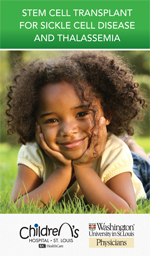A stem cell transplant can offer a cure for some children with sickle cell disease or thalassemia.
St. Louis Children’s Hospital’s pediatric Stem Cell Transplant and Cellular Therapy Program is a national leader in developing safer, more effective ways to provide these transplants to young patients.
What Is A Stem Cell Transplant?
A stem cell transplant replaces a child’s abnormal blood cells with healthy cells from a matched donor. This halts the production of diseased cells. Stem cells can come from:
- Bone marrow (bone marrow transplant)
- Circulating blood
- Umbilical cord blood
We offer three types of treatment:
- Stem cell transplant: Stem cells are extracted from the blood of a donor.
- Bone marrow transplant: Stem cells are extracted from bone marrow from a donor during a minor surgery.
- Cellular therapy: Stem cells are taken from the patient and altered before they are placed back in the bloodstream.
Reduced intensity conditioning
Before the transplant, children receive chemotherapy to destroy the unhealthy blood cells. We perform reduced-intensity stem cell transplants, which use lower doses of chemotherapy. These lower doses lead to fewer long-term side effects.
Benefits of stem cell transplants
Stem cell transplants can help children who have sickle cell or thalassemia in a number of ways, including:
- Providing a cure
- Stopping uncomfortable side effects, such as pain and fatigue
- Eliminating the need for ongoing treatment, such as transfusions
Who Is Eligible for A Stem Cell Transplant?
We look at your child’s symptoms and disease severity before considering a transplant. We will work with you to determine whether the risks of transplant side effects outweigh the damage the disease does to the body.
The stem cell transplant process takes some time. Children are in the hospital for 4-6 weeks. The transplant is not easy on a child’s body. There are a number of potential side effects. But the process may be worth it for some patients.
Side effects
Possible side effects of a transplant include:
- Infections
- Graft vs. host disease, in which the body’s immune system attacks the new cells
- Rejection of the transplant
- Infertility
- Gastrointestinal side effects, such as nausea, vomiting and diarrhea
Why Choose Us for Sickle Cell or Thalassemia Stem Cell Transplants?
Your child will receive care from an experienced stem cell transplant team with a wide range of specialists. Our stem cell transplant doctors are also researchers. Their scientific findings — such as manipulating cells to expand the list of available family donors, and searching for new treatments to prevent graft vs. host disease — have expanded treatment options for all children who receive these transplants.
Who Can Be A Stem Cell Donor?
Stem cells must come from a matched donor who has the same human leukocyte antigen (HLA) tissue type. A matched donor may be:
- A brother or sister with the same parents
- An unrelated donor chosen through the National Marrow Donor program registry
- A half-matched family member, such as a parent or child
Where Can I Learn More About Stem Cell Transplants?
 Read our stem cell transplant brochure (PDF) to find out how a transplant can help your child, and visit our Stem Cell Transplant and Cellular Therapy Program page.
Read our stem cell transplant brochure (PDF) to find out how a transplant can help your child, and visit our Stem Cell Transplant and Cellular Therapy Program page.
Make an Appointment
Call 800.678.5437 to make an appointment or request an appointment online.










